
- Index
- Listed By
- Material
- Size
- Style
- Abstract (20)
- Abstract, Modernism (6)
- Americana (5)
- Art Deco (9)
- Art Nouveau (4)
- Art, Realism (4)
- Dutch (4)
- Dutch, Realism (5)
- Expressionism (23)
- Folk Art (9)
- Impressionism (150)
- Impressionist (5)
- Modernism (12)
- Portraiture (6)
- Realism (163)
- Still Life (22)
- Traditional (10)
- Traditional, Realism (4)
- Victorian (18)
- Vintage (58)
- Other (476)
- Subject
- Unit Of Sale
GIOVANNI FRANCESCO BARBIERI ANTIQUE OLD MASTER ITALIAN OIL PAINTING GUERCINO 17c
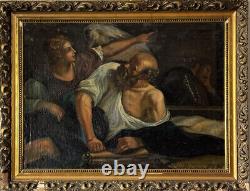
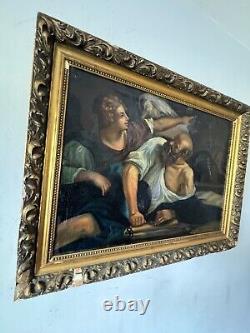

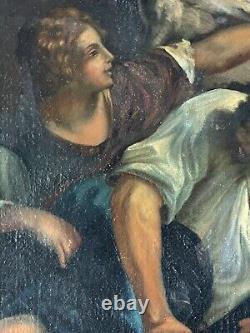







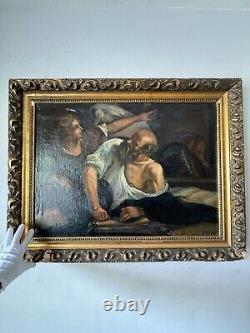











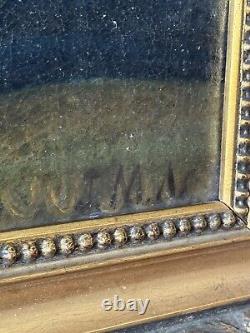


THIS IS A VERY OLD AND ULTRA RARE COPY OF THE ICONIC AND HISTORICALLY IMPORTANT 15TH CENTURY ITALIAN OLD MASTER IMPRESSIONIST OIL PAINTING ON CANVAS TITLED SAINT PETER FREED BY AN ANGEL IN THE STYLE OF AND ATTRIBUTED TO THE GREAT ITALIAN MASTER GIOVANNI FRANCESCO BARBIERI AKA (GUERCINO). THIS WORK IS TITLED SAINT PETER FREED BY AN ANGEL. ORIGINALLY PAINTED BY GUERCINO IN c1622.
THIS PARTICULAR PAINTING WAS PAINTED AROUND THE 1800s, POSSIBLY EARLIER JUDGING BY THE ORIGINAL CANVAS. IT APPEARS THAT IT WAS RELINED AT SOME POINT; WE COULD SEE THE ORIGINAL CANVAS AND HOW IT WAS RESTORED TO A LATER CANVAS. PLEASE ENLARGE THE PHOTOGRAPHS FOR A DETAILED CONDITION REPORT. EACH DELICATE BRUSHSTROKE IS RENDERED WITH PRECISION AND PAINSTAKING ATTENTION TO DETAIL. THE DETAILS ARE SPOT-ON AND AMAZING.
IT IS SIGNED WITH THREE LETTERS IN THE LOWER RIGHTHAND CORNER. PERHAPS YOU RECOGNIZE THE ARTIST? IT'S OVER 200 YEARS OLD. THERE IS MILD CRAQUELURE WEAR AND CHIPS TO THE FRAME, AS SHOWN.
IT DOES NOT DETRACT FROM ITS BEAUTY IN ANY WAY. FEEL FREE TO MAKE AN OFFER. DIMENSIONS INCLUDING THE FRAME: 29" H x 38" W.
Giovanni Francesco (Guercino) Barbieri (1591 - 1666) was active/lived in Italy. Giovanni Barbieri is known for Figure, allegorical painting, fresco. Born: 1591 - Cento, Italy. Died: 1666 - Bologna, Italy.
Giovanni Francesco Barbieri was called Guercino which means the squint-eyed. He was born in Cento, Italy in 1591. He displayed precocious talent as a child, and studied under several local masters. He then went on to Bologna and received instruction from Cremonini and Gennari. He also visited Venice, Ferrara and Rome and in the latter city enjoyed the protection of Pope Gregory XV until that Pontiff's death in 1623, at which time Guercino left Rome and established himself at Cento, where he remained and worked for the next twenty years. In 1626 he began the enormous fresco work on the Duomo at Piancenza, which is probably his greatest and most distinctive accomplishment. Despite his considerable talent, he lacked creative originality and was very much influenced at first by the painting of Caravaggio. TITLE: SAINT PETER FREED BY AN ANGEL. Saint Peter is miraculously freed from prison in Jerusalem (Acts 12, 1-11) by an angel so that he can continue to evangelize. The chains and shackles lying open on the floor and the angel pointing toward the exit allow us to follow the action. The two figures are very much in the foreground and are adapted to the format of the canvas. They appear to be conversing.The angel's youthful appearance contrasts with the aged and wrinkled skin of Saint Peter. The guard can be seen sleeping in the background. Acts 12:3-19 says that Peter was imprisoned by King Herod, but the night before his trial, an angel appeared to him and told him to leave.
Peter's chains fell off, and he followed the angel out of prison, thinking it was a vision (verse 9).

